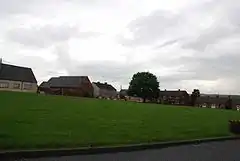Byers Green
Byers Green is a village and former civil parish, now in the parish of Spennymoor, in the County Durham district, in the ceremonial county of Durham, England. It is situated to the north of Bishop Auckland, between Willington and Spennymoor, and a short distance from the River Wear. It has a population of 672.
| Byers Green | |
|---|---|
 The village green | |
 Byers Green Location within County Durham | |
| Population | 672 [1] |
| OS grid reference | NZ223340 |
| Civil parish | |
| Unitary authority | |
| Ceremonial county | |
| Region | |
| Country | England |
| Sovereign state | United Kingdom |
| Post town | SPENNYMOOR |
| Postcode district | DL16 |
| Dialling code | 01388 |
| Police | Durham |
| Fire | County Durham and Darlington |
| Ambulance | North East |
| UK Parliament | |
Byers Green Hall has been the home of the Trotter family since the 15th century.[2]
Thomas Wright, (1711–1786) a famous 18th-century astronomer, architect and mathematician was born and died here. Wright was educated in King James I Grammar School in Bishop Auckland before being apprenticed to a clockmaker in the town. By 1734, after various adventures, Wright had progressed to making a huge working model of the universe (an orrery) for an aristocratic London patron. This set him on his remarkable career that included the first accurate description of the Milky Way.
Professor Harold Orton, (1898–1975) a noted 20th-century linguist and English dialectologist was also born here. Harold Orton was the son of a schoolmaster at Byers Green and attended King James I Grammar School in Bishop Auckland followed by Merton College, Oxford. His 1933 book The Phonology of a South Durham Dialect, based on the dialect of the area, was re-published by Routledge in 2015.[3]
Sir Percy Cradock, GCMG, (1923–2010) a senior British civil servant, was born in Byers Green. He was educated at Alderman Wraith Grammar School, Spennymoor followed by St John's College, Cambridge, where he read law. Having trained as a barrister Cradock joined the Diplomatic Service and during his career held a number of senior diplomatic posts, including Ambassador to China. Later in his career he was labelled by the media as the 'UK's most senior spy' because he chaired the Joint Intelligence Committee (UK) under Margaret Thatcher's government. Cradock died in London on 22 January 2010, aged 86.
It is not known whether there was a village at Byers Green in the Anglo-Saxon period. The village name is quite late; it was first recorded in 1345 as Bires. It is probably the exact equivalent of the modern word 'byres'. The village name thus means '(the green by the) cowsheds'.
Byers Green remained a farming area throughout the medieval period and into the 16th and 17th century. Most people would have worked on the land.
Transport

Byers Green railway station was opened in 1837 by the Clarence Railway, after it opened its Byers Green branch from Ferryhill in 1837.[4] From 1840 it became a junction station, between the Clarence and the West Durham Railway towards Crook. Passenger services were withdrawn on 4 December 1939, when the passenger service from Ferryhill was cut back to Spennymoor. Goods were handled at Byers Green until 2 June 1958.
Since the line was lifted in the late 1960s, the station buildings have been demolished, but the site is part of the Auckland County walking system.
Civil parish
Byers-Green was formerly a township and chapelry in the parish of Auckland St. Andrew,[5] from 1866 Byers Green was a civil parish in its own right, on 1 April 1937 the parish was abolished to form Spennymoor and Crook and Willington, part also went to Bishop Auckland.[6] In 1931 the parish had a population of 1962.[7]
References
- Settlement Summary Sheets.xls Archived 2007-09-27 at the Wayback Machine
- "Trotter of Byers Green Hall".
- Routledge page for The Phonology of a South Durham Dialect by Harold Orton
- "Clarence Railway". Durham History. Retrieved 18 March 2013.
- "History of Byers Green, in Sedgefield and County Durham". A Vision of Britain through Time. Retrieved 6 August 2023.
- "Relationships and changes Byers Green CP/Tn/Ch through time". A Vision of Britain through Time. Retrieved 6 August 2023.
- "Population statistics Byers Green CP/Tn/Ch through time". A Vision of Britain through Time. Retrieved 6 August 2023.
External links
![]() Media related to Byers Green at Wikimedia Commons
Media related to Byers Green at Wikimedia Commons